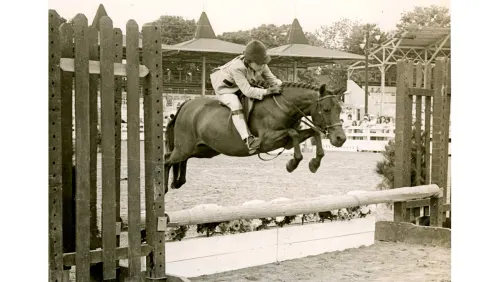In this Between Rounds column originally published in May 2008, our columnist discussed how he would like to see more emphasis placed on the seat for the benefit of the rider and the horse.
The subject of the dressage seat came to mind after I finished conducting my annual Young Dressage Horse Trainers Symposium last winter with guest trainer and friend Michael Klimke.
I often see riders being corrected for their seat, their hands, their shoulders, or anything related to their position, and often when this happens we see riders begin to shut down, overreact or become tense.
I think the way we as instructors deliver this message is vitally important. For example, if we phrase the message in coaching terms vs. correctional terms, and offer it or implement it at the right time, this message creates an educational opportunity for the riders and not a confrontation or rebuke.
Many times it’s a matter of helping the riders to get comfortable, for example by saying “…now work on this; try to sit deeper.” We want them to feel as though they’re being “coached” to work on these issues and not simply corrected.
What truly impressed me during the Young Dressage Horse Trainers Symposium was that the group of about 60 trainers gathered together were focused on “working on the seat” with our demonstration riders. I was impressed with this group because they were open to taking the time to work on the seat, which is one of the most important aids.
Whether a professional, adult amateur, young rider or junior, the connection between the horse and the rider is of utmost importance. For riders who love their horses and want to present them to their very best, the more your seat can go with the motion, be effective and not restrict the horse, the more balanced you are in your position and the more supple you can remain in the rest of your foundation. If you have a large-moving young horse, you need to be able to absorb that motion without restriction. We simply cannot work on this enough.
ADVERTISEMENT
Years ago there was quite an emphasis on longeing and work on the seat; many riding schools stressed this teaching. In more recent times, however, we don’t concern ourselves with the seat as often as in the past.
I’m pleased to say that one specific program (and there are many more such as those offered through the U.S. Equestrian Federation and Lendon Gray’s program Dressage For Kids) does emphasize the seat—the program my mother, the late Jill Hassler-Scoop, started through Equestrian Education Systems.
While collaborating on a book with Eckart Meyners, whose emphasis is on the seat, my mother developed workshops that stressed this aspect of education. Jill used and marketed the Balimo Chair for this purpose.
I think it’s great when riders take the time to work on their seat, and I encourage many more programs to emphasize this work (which can even be offered through everyday instruction). This lesson should be a continual work in progress. Too often we skip over developing the seat, not through lack of caring about it, but because we’re unsure “how” to work on it.
There’s nothing more beautiful and more pleasing to watch in dressage than a beautifully elastic, moving horse with a rider totally in sync with an absorbing seat and the rest of the aids following: a quiet leg, quiet hand and coordination. Any time you can work on the rider’s seat, you benefit the horse too.
I work with many amateurs and find it common for them to work on their seat, even just for fun.
ADVERTISEMENT
Sometimes, however, riders are overly sensitive and get caught up in mistakes and weaknesses. It’s
important to let go of these thoughts and relax while working to improve your riding. I really encourage this work for the rider’s and horse’s sake.
Many years ago we used to ride without stirrups to develop the seat. As times have changed, many riders value other things: figures, collection, half-pass, etc. We need to remember the seat, however, and build this awareness into our teaching/training practices. It’s as important as working on the shoulder-in or the half-pass or the flying changes.
Even though working on the seat seems simple, sometimes the simplest things are the most important. We want to be the best we can be for our horses, and to do that it’s absolutely, fundamentally important to be working on this skill.
Scott Hassler
Scott Hassler, the National Young Horse Dressage Coach, resides in Chesapeake City, Md., and has trained many horses to Grand Prix. The U.S. Dressage Federation Sport Horse Committee chairman since 2001, he helped establish the sport/breeding record-keeping system now active in the USDF and U.S. Equestrian Federation. He began writing Between Rounds columns in 2005.















